Employment Dispute and Resolution
VerifiedAdded on 2022/11/15
|9
|2553
|348
AI Summary
This paper focuses on the various unsatisfactory issues faced by an employee and the employer expectation on dealing with those issues. The study is carried out by understanding the usefulness of legal provisions, statutes and considering the realities of the employment situation in the economy.
Contribute Materials
Your contribution can guide someone’s learning journey. Share your
documents today.
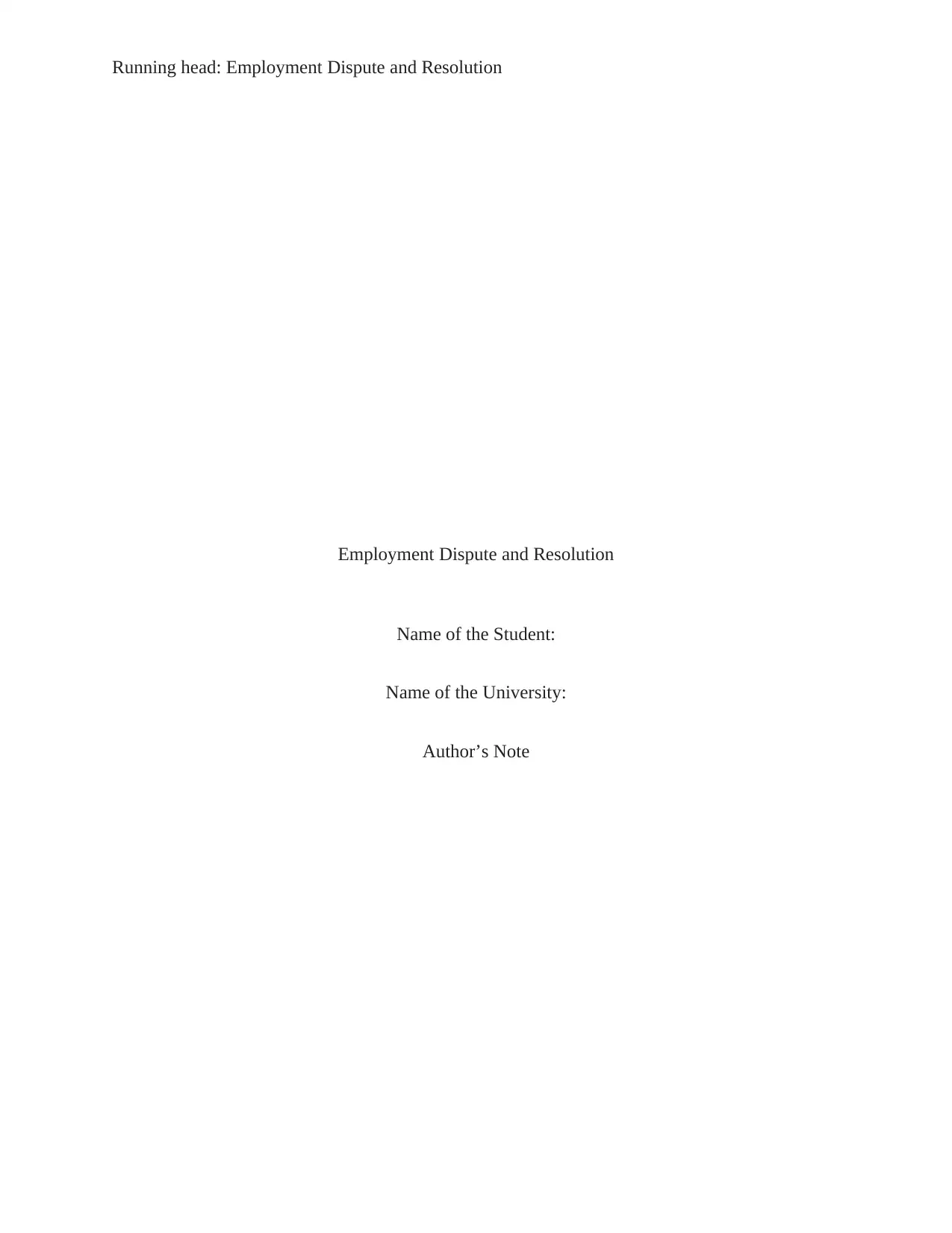
Running head: Employment Dispute and Resolution
Employment Dispute and Resolution
Name of the Student:
Name of the University:
Author’s Note
Employment Dispute and Resolution
Name of the Student:
Name of the University:
Author’s Note
Secure Best Marks with AI Grader
Need help grading? Try our AI Grader for instant feedback on your assignments.
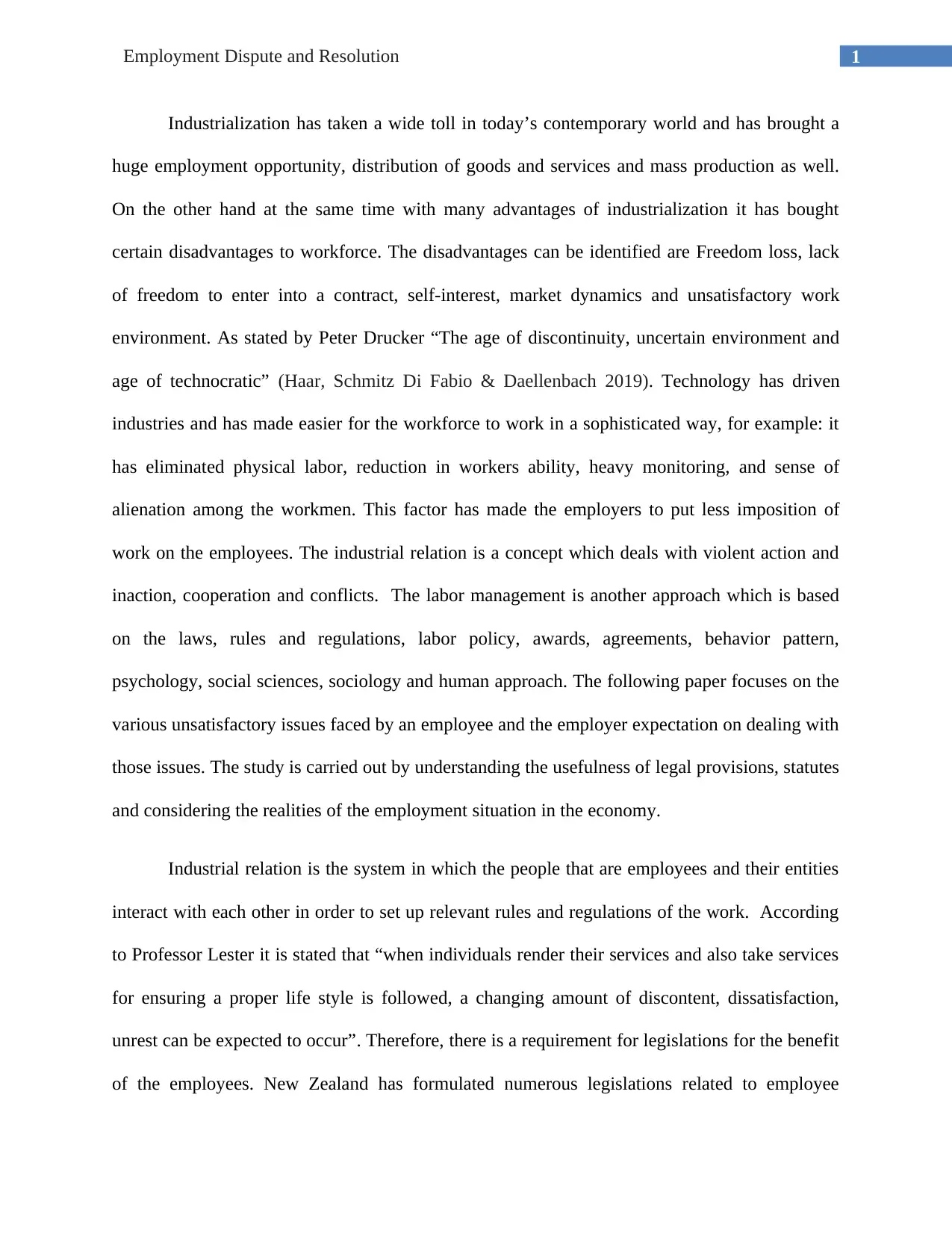
1Employment Dispute and Resolution
Industrialization has taken a wide toll in today’s contemporary world and has brought a
huge employment opportunity, distribution of goods and services and mass production as well.
On the other hand at the same time with many advantages of industrialization it has bought
certain disadvantages to workforce. The disadvantages can be identified are Freedom loss, lack
of freedom to enter into a contract, self-interest, market dynamics and unsatisfactory work
environment. As stated by Peter Drucker “The age of discontinuity, uncertain environment and
age of technocratic” (Haar, Schmitz Di Fabio & Daellenbach 2019). Technology has driven
industries and has made easier for the workforce to work in a sophisticated way, for example: it
has eliminated physical labor, reduction in workers ability, heavy monitoring, and sense of
alienation among the workmen. This factor has made the employers to put less imposition of
work on the employees. The industrial relation is a concept which deals with violent action and
inaction, cooperation and conflicts. The labor management is another approach which is based
on the laws, rules and regulations, labor policy, awards, agreements, behavior pattern,
psychology, social sciences, sociology and human approach. The following paper focuses on the
various unsatisfactory issues faced by an employee and the employer expectation on dealing with
those issues. The study is carried out by understanding the usefulness of legal provisions, statutes
and considering the realities of the employment situation in the economy.
Industrial relation is the system in which the people that are employees and their entities
interact with each other in order to set up relevant rules and regulations of the work. According
to Professor Lester it is stated that “when individuals render their services and also take services
for ensuring a proper life style is followed, a changing amount of discontent, dissatisfaction,
unrest can be expected to occur”. Therefore, there is a requirement for legislations for the benefit
of the employees. New Zealand has formulated numerous legislations related to employee
Industrialization has taken a wide toll in today’s contemporary world and has brought a
huge employment opportunity, distribution of goods and services and mass production as well.
On the other hand at the same time with many advantages of industrialization it has bought
certain disadvantages to workforce. The disadvantages can be identified are Freedom loss, lack
of freedom to enter into a contract, self-interest, market dynamics and unsatisfactory work
environment. As stated by Peter Drucker “The age of discontinuity, uncertain environment and
age of technocratic” (Haar, Schmitz Di Fabio & Daellenbach 2019). Technology has driven
industries and has made easier for the workforce to work in a sophisticated way, for example: it
has eliminated physical labor, reduction in workers ability, heavy monitoring, and sense of
alienation among the workmen. This factor has made the employers to put less imposition of
work on the employees. The industrial relation is a concept which deals with violent action and
inaction, cooperation and conflicts. The labor management is another approach which is based
on the laws, rules and regulations, labor policy, awards, agreements, behavior pattern,
psychology, social sciences, sociology and human approach. The following paper focuses on the
various unsatisfactory issues faced by an employee and the employer expectation on dealing with
those issues. The study is carried out by understanding the usefulness of legal provisions, statutes
and considering the realities of the employment situation in the economy.
Industrial relation is the system in which the people that are employees and their entities
interact with each other in order to set up relevant rules and regulations of the work. According
to Professor Lester it is stated that “when individuals render their services and also take services
for ensuring a proper life style is followed, a changing amount of discontent, dissatisfaction,
unrest can be expected to occur”. Therefore, there is a requirement for legislations for the benefit
of the employees. New Zealand has formulated numerous legislations related to employee
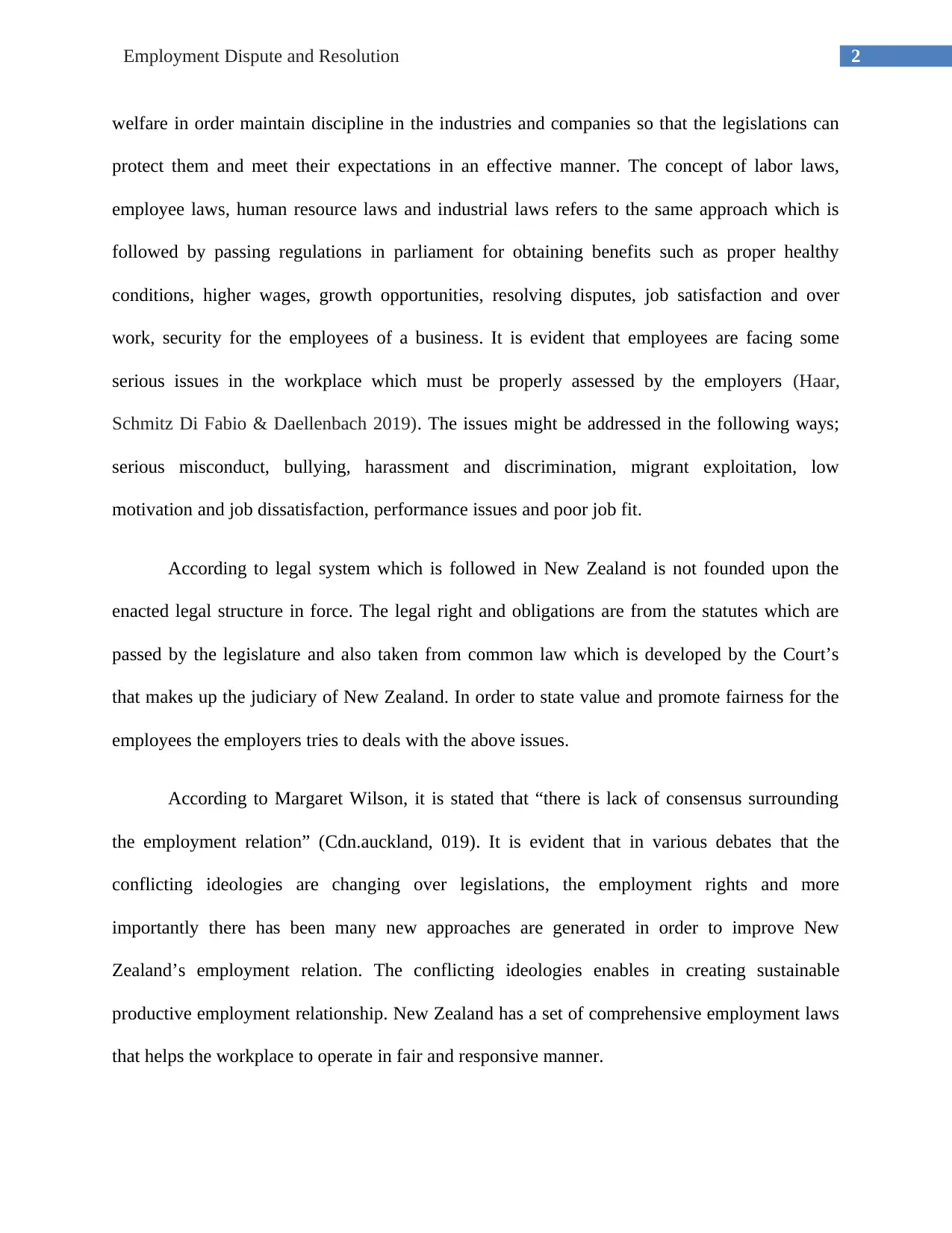
2Employment Dispute and Resolution
welfare in order maintain discipline in the industries and companies so that the legislations can
protect them and meet their expectations in an effective manner. The concept of labor laws,
employee laws, human resource laws and industrial laws refers to the same approach which is
followed by passing regulations in parliament for obtaining benefits such as proper healthy
conditions, higher wages, growth opportunities, resolving disputes, job satisfaction and over
work, security for the employees of a business. It is evident that employees are facing some
serious issues in the workplace which must be properly assessed by the employers (Haar,
Schmitz Di Fabio & Daellenbach 2019). The issues might be addressed in the following ways;
serious misconduct, bullying, harassment and discrimination, migrant exploitation, low
motivation and job dissatisfaction, performance issues and poor job fit.
According to legal system which is followed in New Zealand is not founded upon the
enacted legal structure in force. The legal right and obligations are from the statutes which are
passed by the legislature and also taken from common law which is developed by the Court’s
that makes up the judiciary of New Zealand. In order to state value and promote fairness for the
employees the employers tries to deals with the above issues.
According to Margaret Wilson, it is stated that “there is lack of consensus surrounding
the employment relation” (Cdn.auckland, 019). It is evident that in various debates that the
conflicting ideologies are changing over legislations, the employment rights and more
importantly there has been many new approaches are generated in order to improve New
Zealand’s employment relation. The conflicting ideologies enables in creating sustainable
productive employment relationship. New Zealand has a set of comprehensive employment laws
that helps the workplace to operate in fair and responsive manner.
welfare in order maintain discipline in the industries and companies so that the legislations can
protect them and meet their expectations in an effective manner. The concept of labor laws,
employee laws, human resource laws and industrial laws refers to the same approach which is
followed by passing regulations in parliament for obtaining benefits such as proper healthy
conditions, higher wages, growth opportunities, resolving disputes, job satisfaction and over
work, security for the employees of a business. It is evident that employees are facing some
serious issues in the workplace which must be properly assessed by the employers (Haar,
Schmitz Di Fabio & Daellenbach 2019). The issues might be addressed in the following ways;
serious misconduct, bullying, harassment and discrimination, migrant exploitation, low
motivation and job dissatisfaction, performance issues and poor job fit.
According to legal system which is followed in New Zealand is not founded upon the
enacted legal structure in force. The legal right and obligations are from the statutes which are
passed by the legislature and also taken from common law which is developed by the Court’s
that makes up the judiciary of New Zealand. In order to state value and promote fairness for the
employees the employers tries to deals with the above issues.
According to Margaret Wilson, it is stated that “there is lack of consensus surrounding
the employment relation” (Cdn.auckland, 019). It is evident that in various debates that the
conflicting ideologies are changing over legislations, the employment rights and more
importantly there has been many new approaches are generated in order to improve New
Zealand’s employment relation. The conflicting ideologies enables in creating sustainable
productive employment relationship. New Zealand has a set of comprehensive employment laws
that helps the workplace to operate in fair and responsive manner.
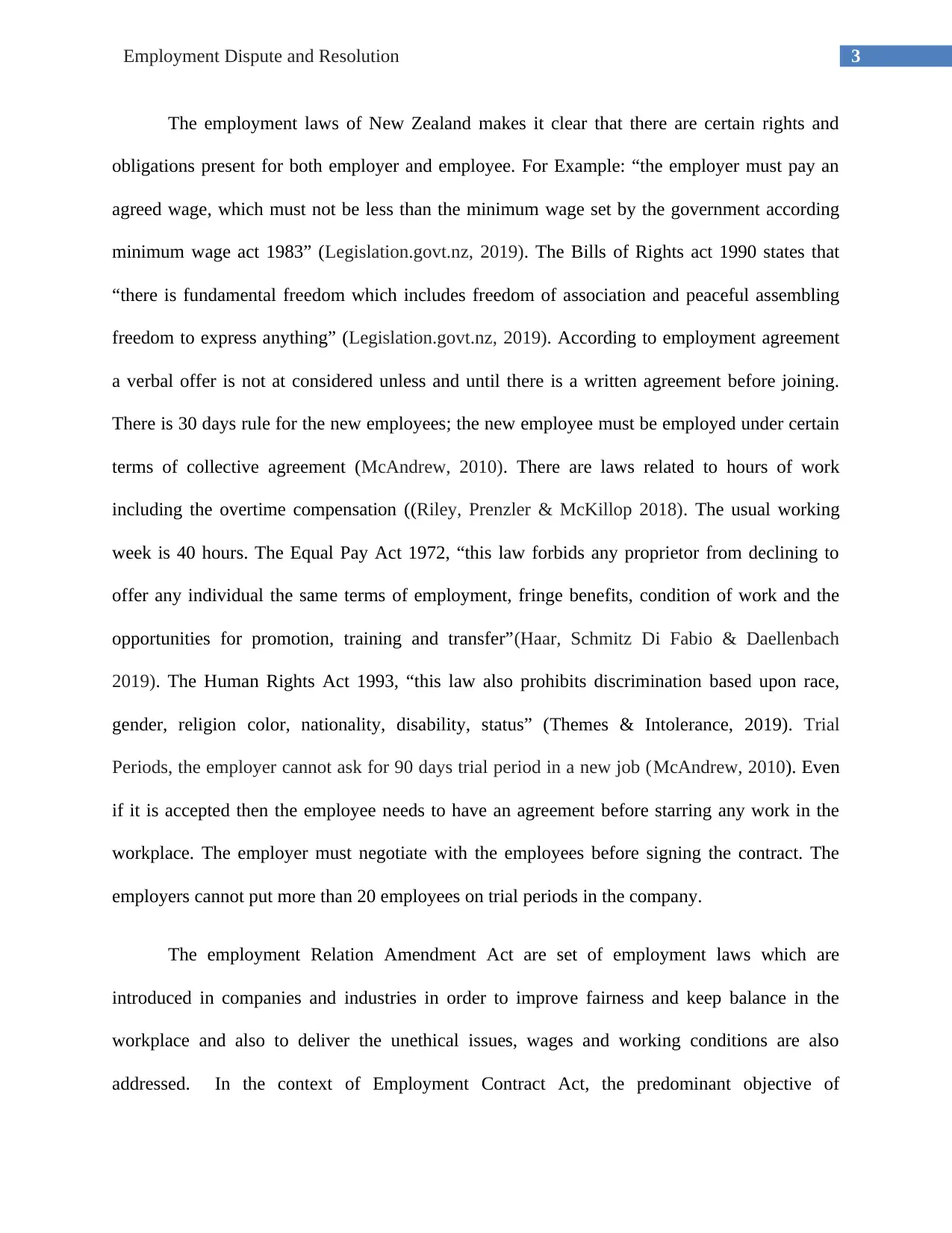
3Employment Dispute and Resolution
The employment laws of New Zealand makes it clear that there are certain rights and
obligations present for both employer and employee. For Example: “the employer must pay an
agreed wage, which must not be less than the minimum wage set by the government according
minimum wage act 1983” (Legislation.govt.nz, 2019). The Bills of Rights act 1990 states that
“there is fundamental freedom which includes freedom of association and peaceful assembling
freedom to express anything” (Legislation.govt.nz, 2019). According to employment agreement
a verbal offer is not at considered unless and until there is a written agreement before joining.
There is 30 days rule for the new employees; the new employee must be employed under certain
terms of collective agreement (McAndrew, 2010). There are laws related to hours of work
including the overtime compensation ((Riley, Prenzler & McKillop 2018). The usual working
week is 40 hours. The Equal Pay Act 1972, “this law forbids any proprietor from declining to
offer any individual the same terms of employment, fringe benefits, condition of work and the
opportunities for promotion, training and transfer”(Haar, Schmitz Di Fabio & Daellenbach
2019). The Human Rights Act 1993, “this law also prohibits discrimination based upon race,
gender, religion color, nationality, disability, status” (Themes & Intolerance, 2019). Trial
Periods, the employer cannot ask for 90 days trial period in a new job (McAndrew, 2010). Even
if it is accepted then the employee needs to have an agreement before starring any work in the
workplace. The employer must negotiate with the employees before signing the contract. The
employers cannot put more than 20 employees on trial periods in the company.
The employment Relation Amendment Act are set of employment laws which are
introduced in companies and industries in order to improve fairness and keep balance in the
workplace and also to deliver the unethical issues, wages and working conditions are also
addressed. In the context of Employment Contract Act, the predominant objective of
The employment laws of New Zealand makes it clear that there are certain rights and
obligations present for both employer and employee. For Example: “the employer must pay an
agreed wage, which must not be less than the minimum wage set by the government according
minimum wage act 1983” (Legislation.govt.nz, 2019). The Bills of Rights act 1990 states that
“there is fundamental freedom which includes freedom of association and peaceful assembling
freedom to express anything” (Legislation.govt.nz, 2019). According to employment agreement
a verbal offer is not at considered unless and until there is a written agreement before joining.
There is 30 days rule for the new employees; the new employee must be employed under certain
terms of collective agreement (McAndrew, 2010). There are laws related to hours of work
including the overtime compensation ((Riley, Prenzler & McKillop 2018). The usual working
week is 40 hours. The Equal Pay Act 1972, “this law forbids any proprietor from declining to
offer any individual the same terms of employment, fringe benefits, condition of work and the
opportunities for promotion, training and transfer”(Haar, Schmitz Di Fabio & Daellenbach
2019). The Human Rights Act 1993, “this law also prohibits discrimination based upon race,
gender, religion color, nationality, disability, status” (Themes & Intolerance, 2019). Trial
Periods, the employer cannot ask for 90 days trial period in a new job (McAndrew, 2010). Even
if it is accepted then the employee needs to have an agreement before starring any work in the
workplace. The employer must negotiate with the employees before signing the contract. The
employers cannot put more than 20 employees on trial periods in the company.
The employment Relation Amendment Act are set of employment laws which are
introduced in companies and industries in order to improve fairness and keep balance in the
workplace and also to deliver the unethical issues, wages and working conditions are also
addressed. In the context of Employment Contract Act, the predominant objective of
Secure Best Marks with AI Grader
Need help grading? Try our AI Grader for instant feedback on your assignments.
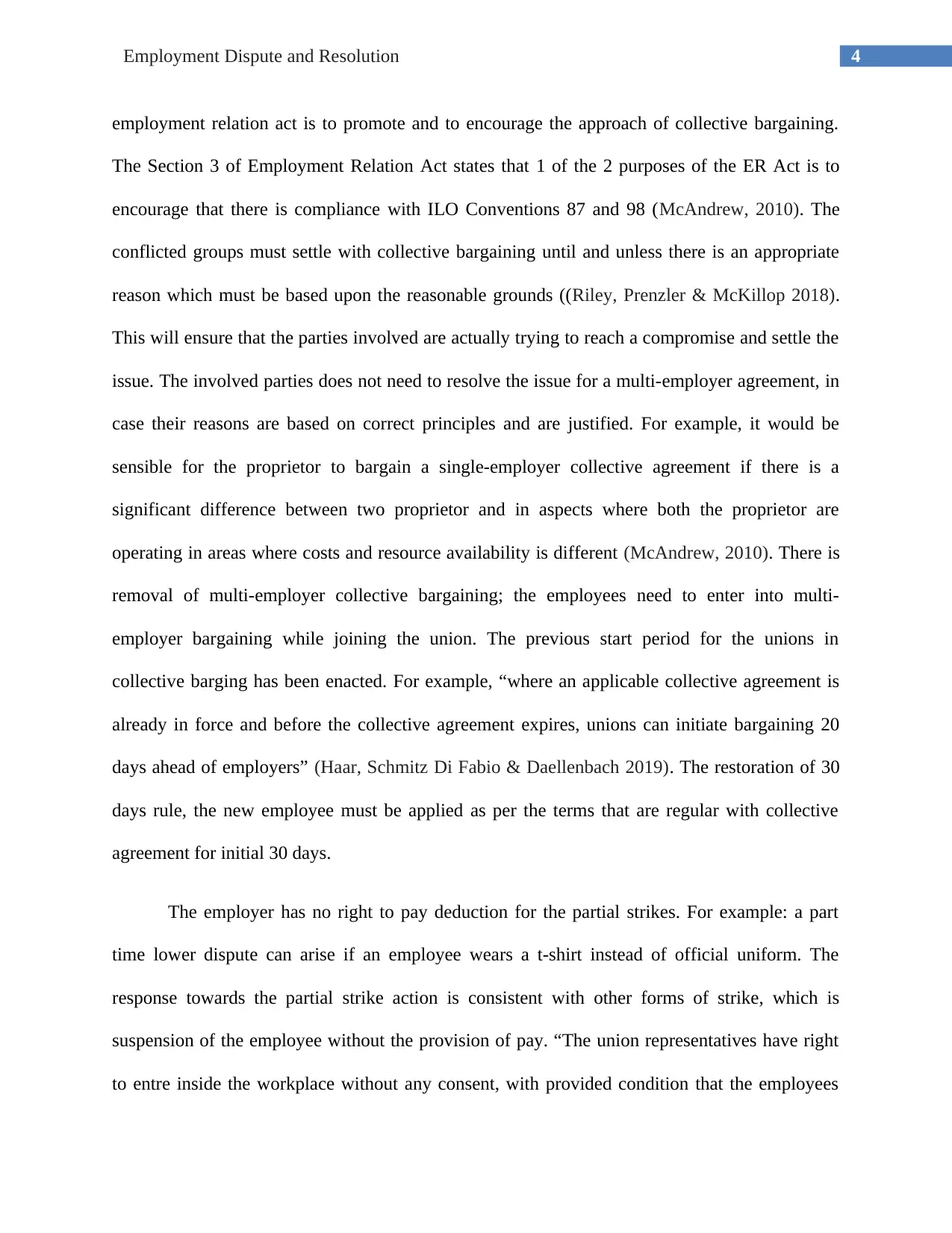
4Employment Dispute and Resolution
employment relation act is to promote and to encourage the approach of collective bargaining.
The Section 3 of Employment Relation Act states that 1 of the 2 purposes of the ER Act is to
encourage that there is compliance with ILO Conventions 87 and 98 (McAndrew, 2010). The
conflicted groups must settle with collective bargaining until and unless there is an appropriate
reason which must be based upon the reasonable grounds ((Riley, Prenzler & McKillop 2018).
This will ensure that the parties involved are actually trying to reach a compromise and settle the
issue. The involved parties does not need to resolve the issue for a multi-employer agreement, in
case their reasons are based on correct principles and are justified. For example, it would be
sensible for the proprietor to bargain a single-employer collective agreement if there is a
significant difference between two proprietor and in aspects where both the proprietor are
operating in areas where costs and resource availability is different (McAndrew, 2010). There is
removal of multi-employer collective bargaining; the employees need to enter into multi-
employer bargaining while joining the union. The previous start period for the unions in
collective barging has been enacted. For example, “where an applicable collective agreement is
already in force and before the collective agreement expires, unions can initiate bargaining 20
days ahead of employers” (Haar, Schmitz Di Fabio & Daellenbach 2019). The restoration of 30
days rule, the new employee must be applied as per the terms that are regular with collective
agreement for initial 30 days.
The employer has no right to pay deduction for the partial strikes. For example: a part
time lower dispute can arise if an employee wears a t-shirt instead of official uniform. The
response towards the partial strike action is consistent with other forms of strike, which is
suspension of the employee without the provision of pay. “The union representatives have right
to entre inside the workplace without any consent, with provided condition that the employees
employment relation act is to promote and to encourage the approach of collective bargaining.
The Section 3 of Employment Relation Act states that 1 of the 2 purposes of the ER Act is to
encourage that there is compliance with ILO Conventions 87 and 98 (McAndrew, 2010). The
conflicted groups must settle with collective bargaining until and unless there is an appropriate
reason which must be based upon the reasonable grounds ((Riley, Prenzler & McKillop 2018).
This will ensure that the parties involved are actually trying to reach a compromise and settle the
issue. The involved parties does not need to resolve the issue for a multi-employer agreement, in
case their reasons are based on correct principles and are justified. For example, it would be
sensible for the proprietor to bargain a single-employer collective agreement if there is a
significant difference between two proprietor and in aspects where both the proprietor are
operating in areas where costs and resource availability is different (McAndrew, 2010). There is
removal of multi-employer collective bargaining; the employees need to enter into multi-
employer bargaining while joining the union. The previous start period for the unions in
collective barging has been enacted. For example, “where an applicable collective agreement is
already in force and before the collective agreement expires, unions can initiate bargaining 20
days ahead of employers” (Haar, Schmitz Di Fabio & Daellenbach 2019). The restoration of 30
days rule, the new employee must be applied as per the terms that are regular with collective
agreement for initial 30 days.
The employer has no right to pay deduction for the partial strikes. For example: a part
time lower dispute can arise if an employee wears a t-shirt instead of official uniform. The
response towards the partial strike action is consistent with other forms of strike, which is
suspension of the employee without the provision of pay. “The union representatives have right
to entre inside the workplace without any consent, with provided condition that the employees
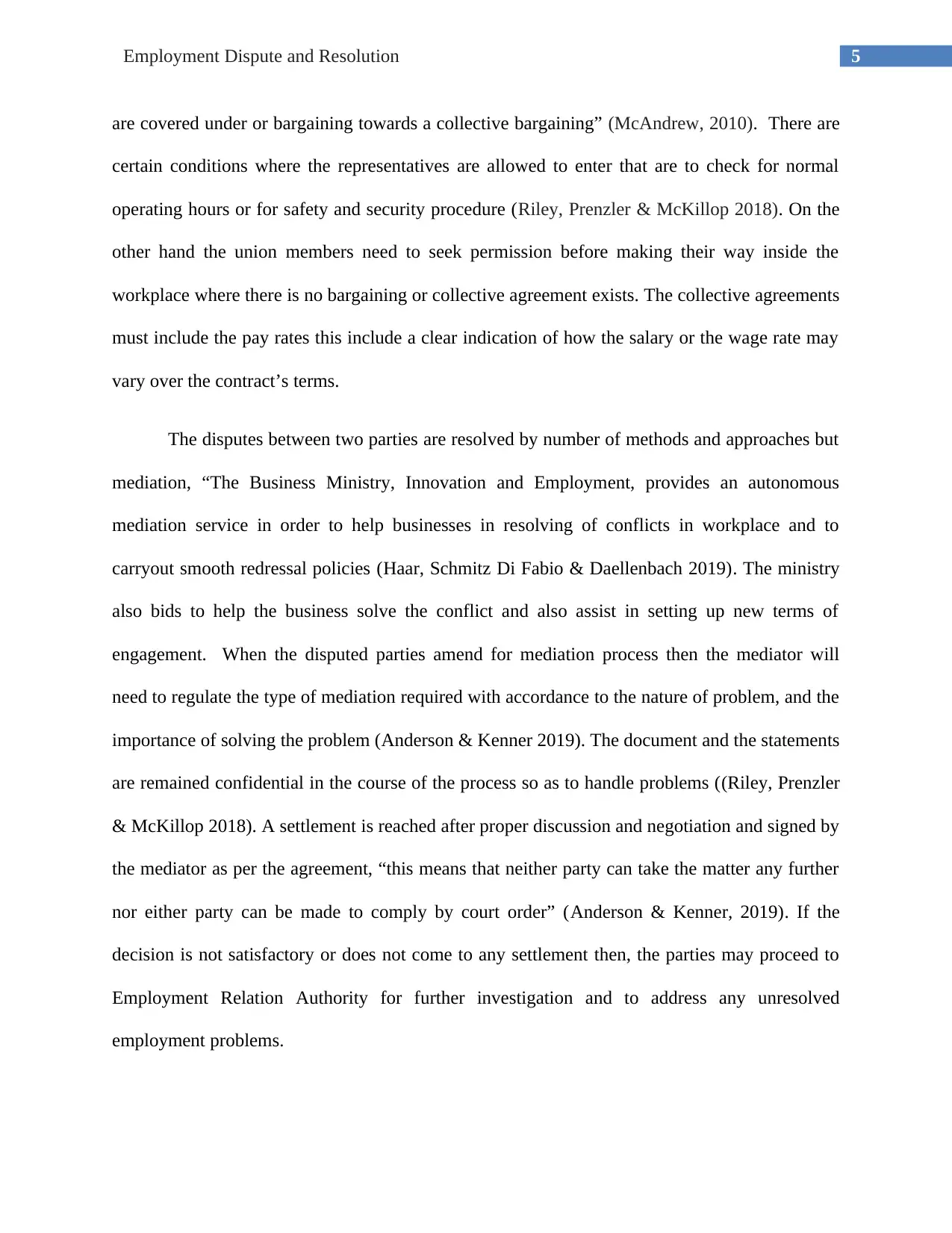
5Employment Dispute and Resolution
are covered under or bargaining towards a collective bargaining” (McAndrew, 2010). There are
certain conditions where the representatives are allowed to enter that are to check for normal
operating hours or for safety and security procedure (Riley, Prenzler & McKillop 2018). On the
other hand the union members need to seek permission before making their way inside the
workplace where there is no bargaining or collective agreement exists. The collective agreements
must include the pay rates this include a clear indication of how the salary or the wage rate may
vary over the contract’s terms.
The disputes between two parties are resolved by number of methods and approaches but
mediation, “The Business Ministry, Innovation and Employment, provides an autonomous
mediation service in order to help businesses in resolving of conflicts in workplace and to
carryout smooth redressal policies (Haar, Schmitz Di Fabio & Daellenbach 2019). The ministry
also bids to help the business solve the conflict and also assist in setting up new terms of
engagement. When the disputed parties amend for mediation process then the mediator will
need to regulate the type of mediation required with accordance to the nature of problem, and the
importance of solving the problem (Anderson & Kenner 2019). The document and the statements
are remained confidential in the course of the process so as to handle problems ((Riley, Prenzler
& McKillop 2018). A settlement is reached after proper discussion and negotiation and signed by
the mediator as per the agreement, “this means that neither party can take the matter any further
nor either party can be made to comply by court order” (Anderson & Kenner, 2019). If the
decision is not satisfactory or does not come to any settlement then, the parties may proceed to
Employment Relation Authority for further investigation and to address any unresolved
employment problems.
are covered under or bargaining towards a collective bargaining” (McAndrew, 2010). There are
certain conditions where the representatives are allowed to enter that are to check for normal
operating hours or for safety and security procedure (Riley, Prenzler & McKillop 2018). On the
other hand the union members need to seek permission before making their way inside the
workplace where there is no bargaining or collective agreement exists. The collective agreements
must include the pay rates this include a clear indication of how the salary or the wage rate may
vary over the contract’s terms.
The disputes between two parties are resolved by number of methods and approaches but
mediation, “The Business Ministry, Innovation and Employment, provides an autonomous
mediation service in order to help businesses in resolving of conflicts in workplace and to
carryout smooth redressal policies (Haar, Schmitz Di Fabio & Daellenbach 2019). The ministry
also bids to help the business solve the conflict and also assist in setting up new terms of
engagement. When the disputed parties amend for mediation process then the mediator will
need to regulate the type of mediation required with accordance to the nature of problem, and the
importance of solving the problem (Anderson & Kenner 2019). The document and the statements
are remained confidential in the course of the process so as to handle problems ((Riley, Prenzler
& McKillop 2018). A settlement is reached after proper discussion and negotiation and signed by
the mediator as per the agreement, “this means that neither party can take the matter any further
nor either party can be made to comply by court order” (Anderson & Kenner, 2019). If the
decision is not satisfactory or does not come to any settlement then, the parties may proceed to
Employment Relation Authority for further investigation and to address any unresolved
employment problems.
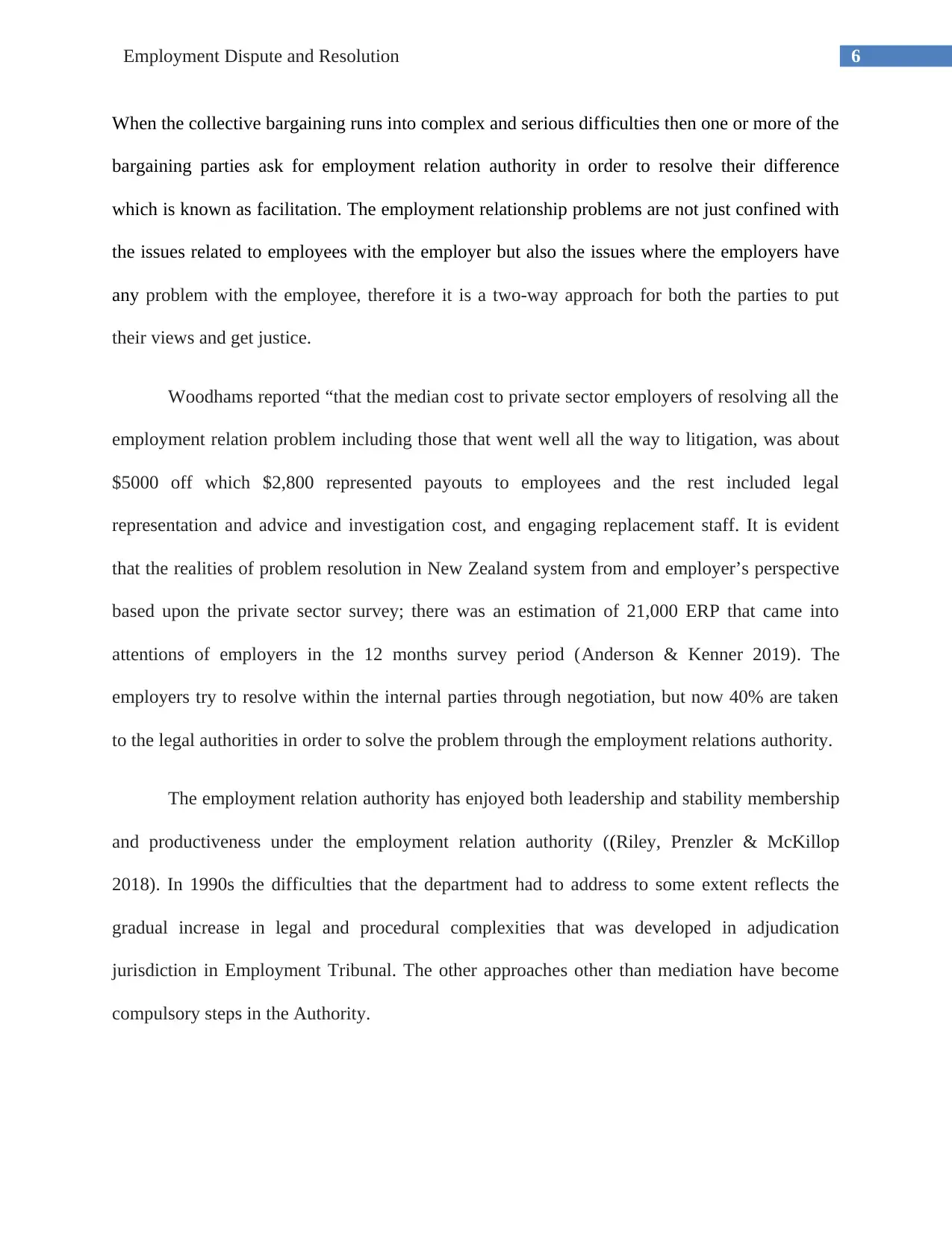
6Employment Dispute and Resolution
When the collective bargaining runs into complex and serious difficulties then one or more of the
bargaining parties ask for employment relation authority in order to resolve their difference
which is known as facilitation. The employment relationship problems are not just confined with
the issues related to employees with the employer but also the issues where the employers have
any problem with the employee, therefore it is a two-way approach for both the parties to put
their views and get justice.
Woodhams reported “that the median cost to private sector employers of resolving all the
employment relation problem including those that went well all the way to litigation, was about
$5000 off which $2,800 represented payouts to employees and the rest included legal
representation and advice and investigation cost, and engaging replacement staff. It is evident
that the realities of problem resolution in New Zealand system from and employer’s perspective
based upon the private sector survey; there was an estimation of 21,000 ERP that came into
attentions of employers in the 12 months survey period (Anderson & Kenner 2019). The
employers try to resolve within the internal parties through negotiation, but now 40% are taken
to the legal authorities in order to solve the problem through the employment relations authority.
The employment relation authority has enjoyed both leadership and stability membership
and productiveness under the employment relation authority ((Riley, Prenzler & McKillop
2018). In 1990s the difficulties that the department had to address to some extent reflects the
gradual increase in legal and procedural complexities that was developed in adjudication
jurisdiction in Employment Tribunal. The other approaches other than mediation have become
compulsory steps in the Authority.
When the collective bargaining runs into complex and serious difficulties then one or more of the
bargaining parties ask for employment relation authority in order to resolve their difference
which is known as facilitation. The employment relationship problems are not just confined with
the issues related to employees with the employer but also the issues where the employers have
any problem with the employee, therefore it is a two-way approach for both the parties to put
their views and get justice.
Woodhams reported “that the median cost to private sector employers of resolving all the
employment relation problem including those that went well all the way to litigation, was about
$5000 off which $2,800 represented payouts to employees and the rest included legal
representation and advice and investigation cost, and engaging replacement staff. It is evident
that the realities of problem resolution in New Zealand system from and employer’s perspective
based upon the private sector survey; there was an estimation of 21,000 ERP that came into
attentions of employers in the 12 months survey period (Anderson & Kenner 2019). The
employers try to resolve within the internal parties through negotiation, but now 40% are taken
to the legal authorities in order to solve the problem through the employment relations authority.
The employment relation authority has enjoyed both leadership and stability membership
and productiveness under the employment relation authority ((Riley, Prenzler & McKillop
2018). In 1990s the difficulties that the department had to address to some extent reflects the
gradual increase in legal and procedural complexities that was developed in adjudication
jurisdiction in Employment Tribunal. The other approaches other than mediation have become
compulsory steps in the Authority.
Paraphrase This Document
Need a fresh take? Get an instant paraphrase of this document with our AI Paraphraser
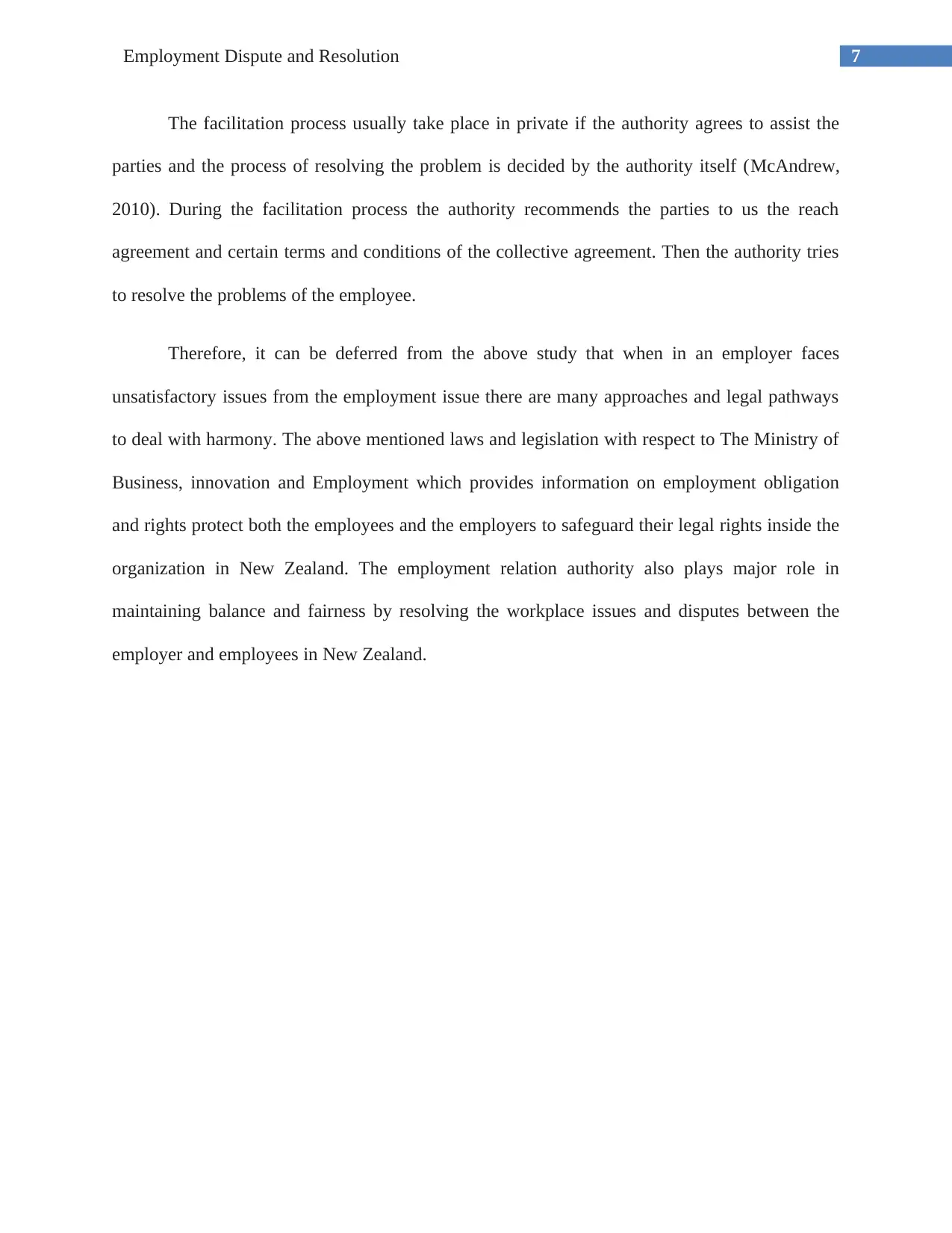
7Employment Dispute and Resolution
The facilitation process usually take place in private if the authority agrees to assist the
parties and the process of resolving the problem is decided by the authority itself (McAndrew,
2010). During the facilitation process the authority recommends the parties to us the reach
agreement and certain terms and conditions of the collective agreement. Then the authority tries
to resolve the problems of the employee.
Therefore, it can be deferred from the above study that when in an employer faces
unsatisfactory issues from the employment issue there are many approaches and legal pathways
to deal with harmony. The above mentioned laws and legislation with respect to The Ministry of
Business, innovation and Employment which provides information on employment obligation
and rights protect both the employees and the employers to safeguard their legal rights inside the
organization in New Zealand. The employment relation authority also plays major role in
maintaining balance and fairness by resolving the workplace issues and disputes between the
employer and employees in New Zealand.
The facilitation process usually take place in private if the authority agrees to assist the
parties and the process of resolving the problem is decided by the authority itself (McAndrew,
2010). During the facilitation process the authority recommends the parties to us the reach
agreement and certain terms and conditions of the collective agreement. Then the authority tries
to resolve the problems of the employee.
Therefore, it can be deferred from the above study that when in an employer faces
unsatisfactory issues from the employment issue there are many approaches and legal pathways
to deal with harmony. The above mentioned laws and legislation with respect to The Ministry of
Business, innovation and Employment which provides information on employment obligation
and rights protect both the employees and the employers to safeguard their legal rights inside the
organization in New Zealand. The employment relation authority also plays major role in
maintaining balance and fairness by resolving the workplace issues and disputes between the
employer and employees in New Zealand.
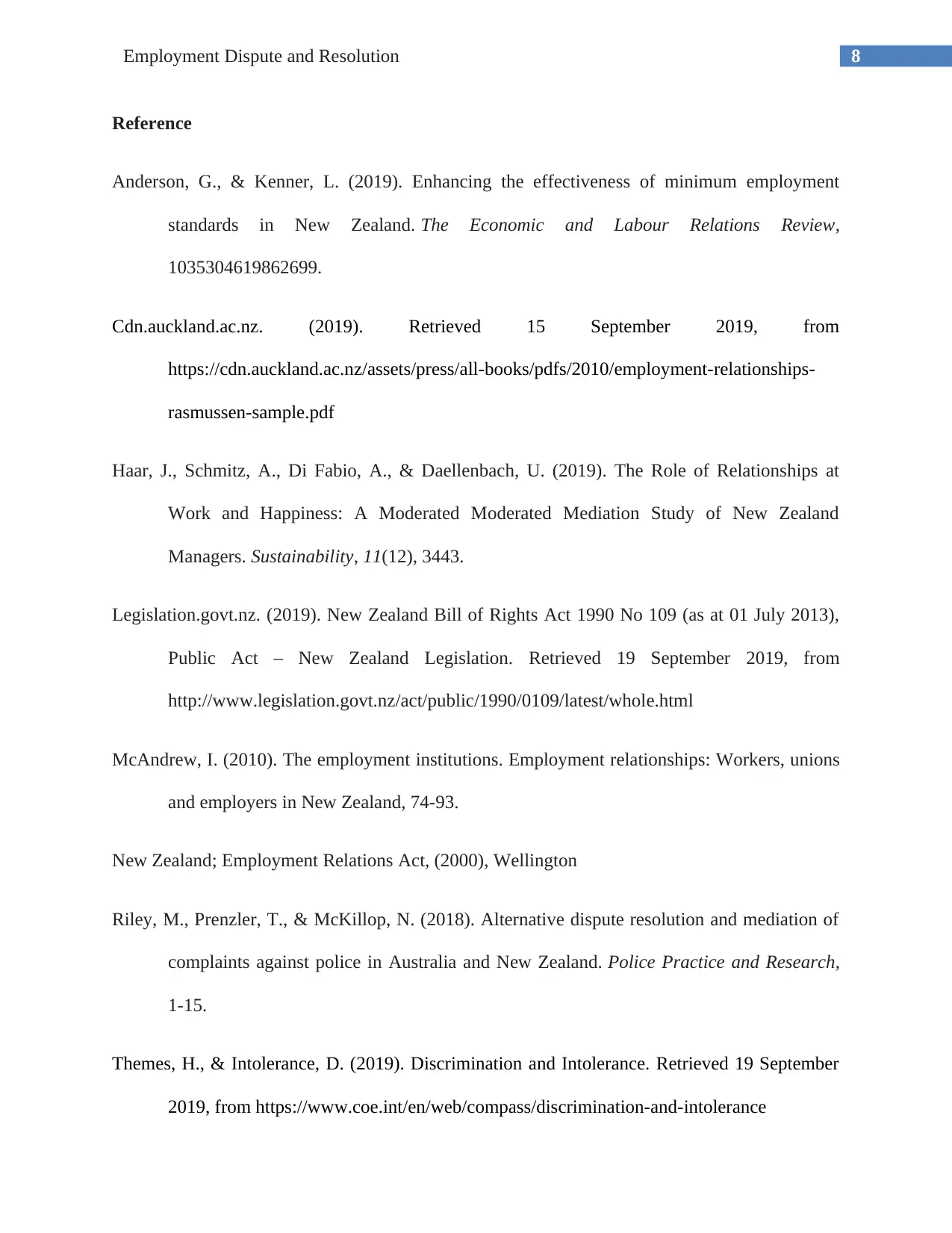
8Employment Dispute and Resolution
Reference
Anderson, G., & Kenner, L. (2019). Enhancing the effectiveness of minimum employment
standards in New Zealand. The Economic and Labour Relations Review,
1035304619862699.
Cdn.auckland.ac.nz. (2019). Retrieved 15 September 2019, from
https://cdn.auckland.ac.nz/assets/press/all-books/pdfs/2010/employment-relationships-
rasmussen-sample.pdf
Haar, J., Schmitz, A., Di Fabio, A., & Daellenbach, U. (2019). The Role of Relationships at
Work and Happiness: A Moderated Moderated Mediation Study of New Zealand
Managers. Sustainability, 11(12), 3443.
Legislation.govt.nz. (2019). New Zealand Bill of Rights Act 1990 No 109 (as at 01 July 2013),
Public Act – New Zealand Legislation. Retrieved 19 September 2019, from
http://www.legislation.govt.nz/act/public/1990/0109/latest/whole.html
McAndrew, I. (2010). The employment institutions. Employment relationships: Workers, unions
and employers in New Zealand, 74-93.
New Zealand; Employment Relations Act, (2000), Wellington
Riley, M., Prenzler, T., & McKillop, N. (2018). Alternative dispute resolution and mediation of
complaints against police in Australia and New Zealand. Police Practice and Research,
1-15.
Themes, H., & Intolerance, D. (2019). Discrimination and Intolerance. Retrieved 19 September
2019, from https://www.coe.int/en/web/compass/discrimination-and-intolerance
Reference
Anderson, G., & Kenner, L. (2019). Enhancing the effectiveness of minimum employment
standards in New Zealand. The Economic and Labour Relations Review,
1035304619862699.
Cdn.auckland.ac.nz. (2019). Retrieved 15 September 2019, from
https://cdn.auckland.ac.nz/assets/press/all-books/pdfs/2010/employment-relationships-
rasmussen-sample.pdf
Haar, J., Schmitz, A., Di Fabio, A., & Daellenbach, U. (2019). The Role of Relationships at
Work and Happiness: A Moderated Moderated Mediation Study of New Zealand
Managers. Sustainability, 11(12), 3443.
Legislation.govt.nz. (2019). New Zealand Bill of Rights Act 1990 No 109 (as at 01 July 2013),
Public Act – New Zealand Legislation. Retrieved 19 September 2019, from
http://www.legislation.govt.nz/act/public/1990/0109/latest/whole.html
McAndrew, I. (2010). The employment institutions. Employment relationships: Workers, unions
and employers in New Zealand, 74-93.
New Zealand; Employment Relations Act, (2000), Wellington
Riley, M., Prenzler, T., & McKillop, N. (2018). Alternative dispute resolution and mediation of
complaints against police in Australia and New Zealand. Police Practice and Research,
1-15.
Themes, H., & Intolerance, D. (2019). Discrimination and Intolerance. Retrieved 19 September
2019, from https://www.coe.int/en/web/compass/discrimination-and-intolerance
1 out of 9
Related Documents
Your All-in-One AI-Powered Toolkit for Academic Success.
+13062052269
info@desklib.com
Available 24*7 on WhatsApp / Email
![[object Object]](/_next/static/media/star-bottom.7253800d.svg)
Unlock your academic potential
© 2024 | Zucol Services PVT LTD | All rights reserved.





